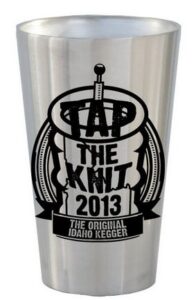Tap the Knit
Billed as “The Original Idaho Kegger” this latest beer fest was held last weekend at the Knitting Factory, a down town live music venue. It was a 1PM – 10PM thing this past Saturday the 26th and I was there checking it out at about 2PM when I figured it wouldn’t be so crowded.
 12$ got me in since I decided against the additional 8$ for the commemorative Stainless tumbler pint “glass”. Actually I am regretting that now, and hope to score one from a leftover pile from somewhere, sometime.
12$ got me in since I decided against the additional 8$ for the commemorative Stainless tumbler pint “glass”. Actually I am regretting that now, and hope to score one from a leftover pile from somewhere, sometime.
For my admission, I got 5 taster tokens and as I scanned the list of a dozen or so Boise area brewers and their 2-3 offerings each, a few peaked my interest right away. McCall Brewing had a Coconut Porter and a Dopplebock that I did not recognize. At their table I chatted with Edgar, their brewer and he practically couldn’t wait to tell me about the beers he brought. He seemed like a good guy and both beers were very good.
Other local brewers participating were: Kilted Dragon, Highland’s Hollow, TableRock, Slanted Rock, The Ram, 10 Barrel, Payette, Sawtooth, Sockeye, Crooked fence, Grand Teton and McCall.
The mini-fest/Kegger was put on in part by the local classic rock radio station so the music was pretty loud, and apparently they had college football on a couple screens but I didn’t even notice. There was only a couple dozen people there, mainly because of the early hour that I attended, and I’m sure that it filled up quite a bit as the evening progressed. It was a bit more personable this way though and it was easier to visit with he brewers/pour-ers at each station.
The venue was interesting and about the right size for the dozen or so brewers that were there. I hope there is a second annual next year and that they are able to fit the additional 8-10 Boise area brewers that will likely be here by then.
-Cheers




